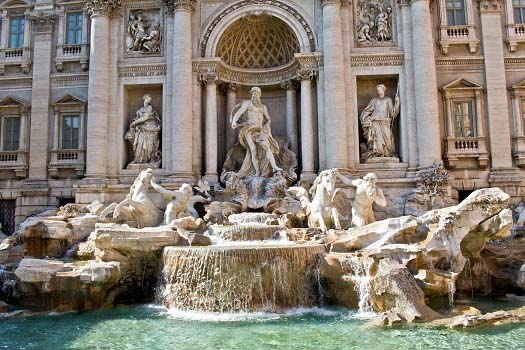Italy’s The Trevi Fountain: A Brief History

Rome: The English poet Percy Blythe Shelley said that “fountains are enough to justify a trip to Rome”. And he was right. The fountains of the Italian capital are many and all are beautiful: the Fountain of Barcaccia in front of the Spanish steps, the Fountain of the Four Rivers in Piazza Navona, the Triton Fountain in Piazza Barberini… but none is as famous as the Trevi Fountain.
Symbol par excellence of Rome, which has become one of the essential stops on a visit to the city, the Trevi Fountain amazes not only for its beauty, but also for its fascinating history. Particularly exalted by Fellini’s film “La Dolce Vita”, it welcomes hundreds of visitors every day, ready to throw a coin into its precious basin.
Despite the fact that the fountain was constructed later than most other fountains in Rome, at the height of Rococo, it has ancient roots. It was in fact realized along with the Aqueduct of the Virgin, built at the time of Emperor Augustus and, in part, the only still functioning Roman Aqueduct of the Roman Empire! As often is the case in the Eternal City, a legend explains its origin. It is said that one day, the brave general Agrippa and his soldiers, particularly thirsty, met a young virgin who, as if by a miracle, made a spring of pure water gush out of the ground. In perpetual memory of the extraordinary event, Agrippa decided to build an aqueduct from the site of the spring that would reach all the way to Rome.
The fountain did not begin to look like it does today until the Renaissance and the time of Pope Nicholas, but the final design, the one we see in the present day, was not made until the 18th century. The architect responsible for its construction was Nicola Salvi, who made it using the great Bernini’s sketches as a base. Unfortunately, Salvi died without being able to see it completed. His successor, Giuseppe Pannini, inaugurated the fountain in 1761.
It is a fountain in Baroque style that represents Neptune, the god of the sea, in the act of taming the waters. It is leaning against the facade of the Palazzo Poli. Initially it seemed destined to be built on the other side of the square, but by order and desire of Pope Urban VIII it was built in front of the Palazzo.
In the center of the fountain, the god Oceanus is portrayed on a chariot pulled by winged horses, led by Tritons. One horse is agitated, the other placid, symbolizing the two aspects of the sea, sometimes calm, sometimes stormy. Next to the god, in two special niches, the statues of Salubrità (Humility) and Abundant (Abundance).
Immediately above the niches, you can clearly distinguish two panels that tell the story of the construction of the Aqueduct of the Virgin: on one side Agrippa stands together with the soldiers, and on the other side the Virgin points to the source of pure water, in reference to the ancient legend.
Looking at the upper façade of the fountain, you will find four other, smaller, allegorical statues (Abundance of fruit, Fertility of the fields, Wealth of Autumn, Amenity of the gardens) and between them, surmounted by an imposing heraldic coat of arms of the pope, there is a large commemorative inscription.
But the opulent decoration does not end here. It is the quantity of details that makes the fountain spectacular. An onlooker is able to distinguish as many as 30 species of plants (bunches of grapes, evergreen plants, canes, figs, ivy, and many others) and numerous animals such as snails and lizards!
Another small curiosity that may be of interest: have you ever noticed that out-of-place travertine vase on the external parapet of the fountain? The Romans nicknamed it, for its shape, “ace of cups” (in reference to the symbol on playing cards), and it seems to have been placed there by Nicola Salvi himself to block the sight of a local barber and who loved to criticize the architects work continuously!
At almost 20 meters wide and 26 meters high, the Trevi Fountain is the largest fountain in Rome. It is not surprising that the fountain uses in excess of 2,824,800 cubic feet of water every single day. Thankfully, the water is recycled unlike in the old days when it simply ended up going to waste.
Although the water in the fountain is kept crystal clean, it did briefly have a different color back in 2007. An activist dumped a red substance into the fountain that turned the water a bright red. Luckily the water was drained and replaced fast enough and no damage was caused to the monument.
Even though its enormously grand, Trevi Fountain can sometimes be difficult to find. It remains hidden among the buildings of the small Trevi Square.
The fountain is located at the junction of three roads. Due to its location, the fountain received a rather literal name Fontana de Trevi which translates to Three Street Fountain. It is further believed that the name was derived from the word ‘trivium’ which means ‘three streets’ in Latin.
Today, the fountain is simply known as Trevi Fountain, both among locals and international visitors alike. Actually, the name Trevi derives from “Tre Vie” (Three Ways) and refers to the point where the three roads that lead into the square meet.
But how did the tradition of throwing a coin into the fountain, which guarantees a safe return to Rome, come about? Obviously we have to go back in time, when it was customary to throw small gifts into the sacred fountains to satisfy the gods, like wishing wells!
Legend has it that whoever tosses a coin from behind their back into the Trevi Fountain makes sure they will return to Rome. To do it right you need to hold the coin with your right hand, stand with your back to the fountain and toss the coin by passing it over your left shoulder.
If you flip two coins instead of one, you will find love, and if you flip three, you assure marriage (or divorce, if you are already married…). Many have testified that it is true! Have you tried?
Something that is a scientific fact, though, is that this custom produces revenues of almost one million euros a year. On occasion, the fountain collects up to 3,000 euros in a single day!
And what happens to the coins? You’ll be happy to know that, since 2007, the money collected in the Trevi Fountain has been donated to Caritas Internationalis and other charities. That being said, there are more than a few occasions when some clever person is caught trying to steal coins from the fountain.
For obvious reasons, removing money from the fountain is illegal. There was one infamous raider, however, who stole coins from the fountain for nearly thirty four years before finally being apprehended in 2002.
One of the most legendary scenes in the history of Italian cinema has the Trevi Fountain as its backdrop. Who doesn’t know, even if they haven’t ever seen the film, the famous scene from “La Dolce Vita” in which Anita Ekberg wades into the fountain and invites Marcello Mastroianni to bathe with her?
Well, there are several admirers of Fellini who have tried to imitate Anita, braving a dip in the fountain, both naked and clothed. However, don’t even think about doing it! Bathing in the Trevi Fountain is prohibited and punishable by fines of up to €500. So, if you’re really hot, it’s best to cool off with a good ice cream!
This one has been published in guide books for decades. The price is a bit higher than average, although in line with the location, and the quality is top notch, as evidenced by the presence of several ‘fridges’ with different temperatures that each flavor requires. One- hundred percent natural ingredients and seasonal flavors, like hazelnut meringue in autumn. A tiny shop, you will find it on a narrow street. They only serve cups, no cones, and there is nowhere to sit down so stroll over to Trevi Fountain to enjoy!
This upscale chain gelateria is a magnificent store with a stunning chocolate waterfall behind the ice cream counter. The craft gelato is excellent, and the whipped cream, or “panna,” super fresh. Romans complain about the price, but they are always lining up for their next scoop. Located down the road from Trevi Fountain, it’s the best stop on your way to the Pantheon. Get the classic cream flavor in summer, and in winter order the indulgent hot chocolate, or “cioccolata calda”.
The closest subway station to Trevi Fountain is Barberini Station. It is located along Line A of the Rome Metro.
The distance between Barberini Station and the Trevi Fountain is only about 600 meters, and on foot it takes about 7 minutes to reach the monument.
After exiting the station, all you have to do is walk first down Via del Tritone, veering left, and then continue along Via dell’Arcione.
The number 75 stops closest to Trevi Fountain. This bus can also be taken by those arriving from Fiumicino airport.
For those staying in the Villa Borghese area, you can simply reach the fountain by taking bus number 160 and then transfer to bus number 85.
Those who are near the Vatican can get to the Trevi Fountain by taking bus number 64 first and then bus number 87.
The price for a single ticket valid for 100 minutes from the moment of purchase is 1.50 euros.
The Trevi Fountain has been one of the most popular attractions in all of Italy for centuries and will continue to be so for many years to come. With its rich history and astounding design it is bound to leave locals and tourists in awe until the end of time.





